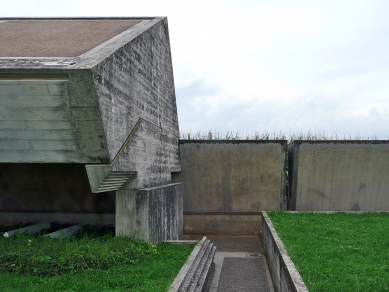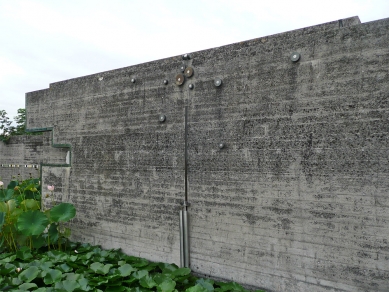
Hřbitov rodiny Brion-Vega

„From the village the site is approached through a private entrance: here is the church, where funeral services are held, the village cemetery, and here is the chapel – this is accessible to the public blic because the ground belongs to the estate.. The family has the right only to be buried there. A private path leads to the little pavilion on the water – the only really private areal on the site. This is basically all there is. This place of the death is little like a garden. Incidentally, the great American cemeteries of the nineteenth century, in Chicago, for example, are extensive parks. No Napoleonic tomb, no! You can drive in with your car. There are beautiful monuments for example those by Louis Henry Sullivan.
Cemeteries now have become mere piled-up shoe boxes, one on top of the other. I wanted to express the naturalness of water and meadow, of water and earth. Water is the source of life.“
Apart from the fact that the description by Scarpa quoted at length here explains his motives and preference as an architect it reminds those who knew him of his ironical way of speaking about architecture. His lectures were charming conversations quite devoid of any academic tone.
Scarpa designed the Brion tomb during the student revolt in Italian universities. Architecture was forgotten, politically ittelevant. Scarpa was director of the Venice faculty, an institute which no one at the time wanted to run. But his friendly manner disarmed the ubiquitous aggressiveness of the demogogues.
The site is an L-shape situated along two sides of the cemetery ov San Vito. A boundary wall leaning inwards encloses the site with its three centres: the pool around the pavilion, the »arcosolium« at the corner of the »L«, and the chapel. There are two entrances, one direclty from outside to the chapel, the other from the cemetery at the end of the main avenue. This second entrance gives access to the site: Scarpa borrowed the name »propylaeum« from the Acropolis. It leads to a portico, from which one sees the garden through two intersecting mosaic-framed rings.
"With the Brion Cemetery, Scarpa made his impact with an unreserved commitment ot the modern movement and a new sureness of language, in continuity but not imitation of Wagner, Hoffman, Loos, and [Frank Lloyd Wright]. He re-created here the splendor of nineteenth-century Middle Europe, where beauty had the power to redeem man from his limitations. He avoided the narrow dictates of rationalism, choosing rather to stress inner depth, dreams, and nostalgia.
"He did not need new compositional themes or forms. He already knew everything he needed to reach his objective. His original intuitions about the continuity of language and feeling crystallized in the building of this cemetery."
I consider this work, if you permit me, to be rather good and (something) which will even get bette over time. I have tried to put some poetic imagination into it, through not in order to create poetic architecture but to make a certain kind of architecture that could emanate a sense of formal poetry. I mean an expressed form that can become poetry, though, as I said before, you cannot intentionally make poetry.
The deceased had asked to be closed to (the) earth since he was born in this village – so I decided to build a small arch, which I will call arcosolium. (Arcosolium is a latin term from the time of the early Christians in the catacombs. Important persons or martyrs were buried in them.) I used a more costly version... I thought it [was] a good idea for two people who had loved each other to be put in such a way as to be able to greet one another, after death. Soldiers stand erect, movements are human. The arcosolium became an arch, a bridge span, an arch of reinforced concrete and would still have looked like a bridge if I hadn't had it illustrated, I mean decorated. But instread of painting we used mosaic, a Venetian tradition that I interpreted in a different way.
Cemeteries now have become mere piled-up shoe boxes, one on top of the other. I wanted to express the naturalness of water and meadow, of water and earth. Water is the source of life.“
Apart from the fact that the description by Scarpa quoted at length here explains his motives and preference as an architect it reminds those who knew him of his ironical way of speaking about architecture. His lectures were charming conversations quite devoid of any academic tone.
Scarpa designed the Brion tomb during the student revolt in Italian universities. Architecture was forgotten, politically ittelevant. Scarpa was director of the Venice faculty, an institute which no one at the time wanted to run. But his friendly manner disarmed the ubiquitous aggressiveness of the demogogues.
The site is an L-shape situated along two sides of the cemetery ov San Vito. A boundary wall leaning inwards encloses the site with its three centres: the pool around the pavilion, the »arcosolium« at the corner of the »L«, and the chapel. There are two entrances, one direclty from outside to the chapel, the other from the cemetery at the end of the main avenue. This second entrance gives access to the site: Scarpa borrowed the name »propylaeum« from the Acropolis. It leads to a portico, from which one sees the garden through two intersecting mosaic-framed rings.
"With the Brion Cemetery, Scarpa made his impact with an unreserved commitment ot the modern movement and a new sureness of language, in continuity but not imitation of Wagner, Hoffman, Loos, and [Frank Lloyd Wright]. He re-created here the splendor of nineteenth-century Middle Europe, where beauty had the power to redeem man from his limitations. He avoided the narrow dictates of rationalism, choosing rather to stress inner depth, dreams, and nostalgia.
"He did not need new compositional themes or forms. He already knew everything he needed to reach his objective. His original intuitions about the continuity of language and feeling crystallized in the building of this cemetery."
M.A.Crippa, M.L.Randolin, Carlo Scarpa: Theory Design Projects, p.61
I consider this work, if you permit me, to be rather good and (something) which will even get bette over time. I have tried to put some poetic imagination into it, through not in order to create poetic architecture but to make a certain kind of architecture that could emanate a sense of formal poetry. I mean an expressed form that can become poetry, though, as I said before, you cannot intentionally make poetry.
The deceased had asked to be closed to (the) earth since he was born in this village – so I decided to build a small arch, which I will call arcosolium. (Arcosolium is a latin term from the time of the early Christians in the catacombs. Important persons or martyrs were buried in them.) I used a more costly version... I thought it [was] a good idea for two people who had loved each other to be put in such a way as to be able to greet one another, after death. Soldiers stand erect, movements are human. The arcosolium became an arch, a bridge span, an arch of reinforced concrete and would still have looked like a bridge if I hadn't had it illustrated, I mean decorated. But instread of painting we used mosaic, a Venetian tradition that I interpreted in a different way.
Carlo Scarpa: Can architecture be poetry?,1976
P.Noever, Carlo Scarpa: Die andere Stadt, Ernst & Sohn, Berlin 1989, p.17-18
P.Noever, Carlo Scarpa: Die andere Stadt, Ernst & Sohn, Berlin 1989, p.17-18
3 comments
add comment
Subject
Author
Date
Po návštěvě.
Petr Šmídek
21.08.10 03:11
>>Po návštěvě, ... terapie
gallina-scripsit
21.08.10 05:39
re terapie
Vích
23.08.10 06:45
show all comments






























































